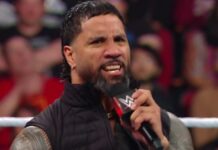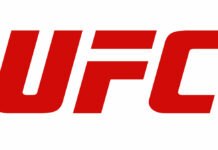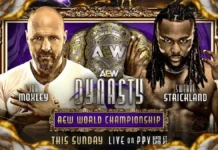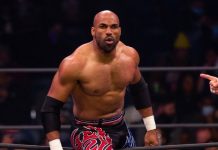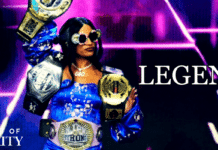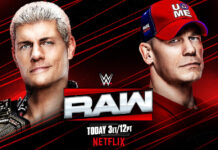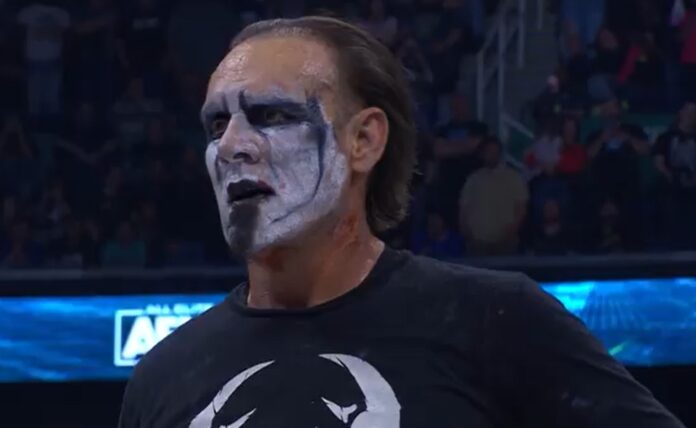
All Elite Wrestling presented its latest pay-per-view offering, Revolution with the biggest selling point being the final bout in the stellar 40-year career of Sting, the franchise player in WCW and an athlete that somehow kept pace throughout the modern era. The event was held on the old Crockett stomping grounds, the Greensboro Coliseum, the same venue that hosted the famous Ric Flair/Sting bout at Clash of The Champions a few decades ago.
As I wrote in an article about Sting’s retirement last week, the under card of this event is almost cannon fodder, as this was a night rightfully for Sting and the success of the show, both in ticket sales and pay-per-view buys, is based on the conclusion of his stellar career.
The show opened with the TNT championship match between Christian and Daniel Garcia. Christian is one of the smartest and best all around workers in the business today, as well as his generation. This segment proved exactly why he is such a ring general, and his work is a level above some of the bad habits that you might often see from other talent on AEW programming. While AEW sells work rate, particularly on pay-per-view, Christian knew that this was an opening match, and there was no reason to have some epic 30-minute Tokyo Dome clash or a ridiculous bump that would ultimately create a pitfall in the pace of the show later in the card.
This wasn’t a match where they worked a chin lock for ten minutes and there was definitely solid action, but the difference between this and some of the amateur hour performances you often see on Dynamite from others on the roster is that this bout used a level of psychology that built to the finish. There weren’t 38 near falls that some misguided notion might consider a false finish when nobody would believe it was the finish anyway. Instead, this contest had a narrative that shifted and built a level of drama with an actual false finish with the pile driver spot. There are times that you’ve seen multiple Canadian destoryers in a match that mean nothing since there are just another move in the match. Christian and Garcia used one pile driver to get the fans to wonder if this was the conclusion of the match, and that’s just one example of how this segment maximized the maneuvers. Everything meant something and it’s a lesson that could be useful for many on the roster. The finish saw Christian get the win in typical heel fashion, and this was a really solid opener, it was probably one of the best Daniel Garcia matches of his AEW tenure.
Next up was Eddie Kingston vs. Bryan Danielson for the Continental championship, and it was exactly what you’d expect from these two grapplers. This was a physical, hard-hitting bout that had the crowd following the entire segment, which is an example of how over both are with the fan base. Eddie’s selling was so key because it gave the match an underdog narrative, which was more or less the entire premise of the storyline. The crowd identifies with Eddie Kingston as the blue collar fighter, and the stiff kicks and strikes from Danielson gave the baby face odds to overcome throughout the contest.
The match had a smart finish, and similar to the opening bout, there weren’t a dozen near falls used as a substitute for compelling storytelling in this match. The selling from both performers was the glue of the bout as the action tilted back and fourth toward the finish. Furthermore, the conclusion was well done and emphasized the physicality of the match when Eddie got the win to retain the championship.
The scramble bout was a replacement match because of some key injuries to scheduled talent, and it looked like this was just a way for Tony Khan to shoehorn as many people on the card as possible. Powerhouse Hobbs and Wardlow had their moments and were showcased well. Outside of that, this was structured or lack thereof to be the fireworks match with as many moves as possible with zero psychology behind any of it. In some cases, that has its place on the card and can work, but it didn’t translate on this show. Besides Hobbs and Wardlow getting some spotlight, there was a rather sloppy segment that didn’t do anything other than burn out the audience, as they’ve just seen nearly every move in the book in less than 15 minutes so what else is there for the rest of the card to do later in the night?
The spot where Jericho used a fog machine was a little odd and clunky. Eventually, Wardlow got the win to secure a shot at the world championship, which was needed if for no other reason than the fact that after such an extended build up for the reveal of The Undisputed Kingdom faction, the group hasn’t really done anything worthwhile since the Worlds End pay-per-view, which shows how much of a miss the entire angle was to begin with. As far as Wardlow getting a shot at the title, nothing about the way he has been used in AEW suggests that it will make a difference to his career path since he more or less always stays in the same position in the company.
The International title match was very good in a vacuum, but I’m not sure how much it meant on this particular show in this particular spot on the card. This bout had stiff striking and high impact wrestling, but the same could be said for the Kingston/Danielson bout, with the key difference being that not only was the style done better in the prior contest, but the Continental championship match had a a storyline that the audience was invested it, where as Orange Cassidy/ Roderick Strong just didn’t have a meaningful angle behind it. Don’t get me wrong, Roderick Strong is a very solid talent, and Cassidy, despite the criticism of his character, can go in the ring, but this was essentially a lesser version in terms of style of the Kingston/Danielson bout. Cassidy took a terrifying gut wrench suplex bump on the turnbuckles before Strong won the title.
I’m not sure the International title means much in the grand scheme of things, especially since there’s an alphabet soup collection of belts in the organization, but similar to Wardlow’s win, Strong needed the victory to give the stable some level of importance among the All Elite landscape. A side note, I don’t know who let Roderick Strong walk to the ring wearing a cape and mask from the discount rack of the Spirit Halloween store, but let’s hope we never see the cheap entrance gear again.
I have to be honest, I thought the FTR/Blackpool Combat Club match was a little underwhelming and somewhat disappointing, especially after the 20-minute draw they had on Dynamite a few weeks ago. This was yet another segment based on chops and hard strikes, but the audience already saw that in two previous contests on the card. I expected to see more fast-paced NWA-style tag wrestling, specifically because of where the show took place, but repetitive chops were used as a substitute for compelling wrestling. Along the same lines, Dax blading seemed to be another substitute for intensity, as the blood didn’t add much to the bout. FTR is arguably still the best tag team in the business, and maybe the expectations were unfair, but again, I expected more than this rather one-dimensional presentation. The BCC got the win, but the crowd was relatively quiet throughout the segment, and I’d say that they actually had a better match on TV.
The Women’s title match was in a no-win situation with its place on the card, but the subpar quality didn’t help either. If you thought the crowd was quiet for the tag match, you could hear the popcorn guy selling concession in the bleachers during this match. The crowd was almost completely silent for this segment and seemed to have very little interest, if any at all, in the result of the championship bout. The match was clunky and despite only going about 10 minutes, it still dragged throughout the segment. I understand that everyone gets the artificial debut pop upon their arrival, but Deonna Purrazzo isn’t over with the audience, and unless there’s something major planned for her, she will quickly get lost in the shuffle to become just another name on the B-shows. Toni Storm is supposed to be a heel, but the character was over more than the baby face so it was a good decision to have her retain the belt.
Will Ospreay vs.Konosuke Takeshita was incredible, and this is the bout that should’ve been positioned as the only fireworks match on the card. This was a dazzling spot fest, and the reason that it works is that these are two of the best in the world at that style. When you have two performers of this caliber, there’s no reason to have secondary wrestlers try to do something similar because it’s a cheap imitation by comparison. That’s why from a booking perspective, the type of matches that are going to be booked on a show matter in the overall presentation. This was fast-paced and hard-hitting, and it will be known as one of the best matches in All Elite history. That being said, there were also a few dangerous spots, including the brutal brain buster on the turnbuckles when it looked like Ospreay got spiked on his head.
This is where more wrestlers, specifically in the modern era, should be aware of the risk/reward ratio. Dave Meltzer might give them 84 stars for getting dropped on their head, but he’s not going to pay their mortgage if they get injured. Considering the injury rate of AEW, Ospreay and Takeshita will have to take a measured approach because they can’t draw money or be bigger stars if they’re on the sidelines. Ospreay got the victory, but this was a win for everyone involved, as both of these performers should be used in the main event scene in the future.
The AEW world championship match was in a difficult position, as it had to follow the action of the stellar spot fest, and it had a rather convoluted storyline with the three-way match. I’m not sure what the point was here, because it didn’t spotlight Samoa Joe as the champion, even though he retained the title since he was secondary within the narrative of the match. Samoa Joe is a modern day legend with his extended career and accomplishments, but nothing about his title reign so far showcases that. The whole Swerve/Adam Page angle is somewhat disjointed because Strickland is a heel, but not really and Page is just a whiny baby face that the audience is indifferent toward most of the time on television.
The intro to the main event was very well done. With as much criticism as Tony Khan rightfully gets for his amateur booking style, he presents the legends in the spotlight that they deserve, a stark contrast to the Vince McMahon philosophy. The entrance with Sting being able to share the moment with his sons was very nice. I was hoping that the two teams would keep this rather simple, allow Sting to play the greatest hits since that was all that was needed, and let the moment speak for itself. Unfortunately, they tried to “surprise” viewers with a level of shock value, and in my opinion, it was a total flop. Ric Flair trying to get into the ring to shield Sting at 75 to take a super kick was embarrassing. The ridiculous bump that Darby took through the glass and the grotesque damage it did to his back is something that should be reserved for two hundred fans in a parking lot on an independent show. Sting getting thrown through glass in his last match wasn’t memorable, it was just unnecessary. This retirement match should’ve highlighted the final Stinger splash and the Scorpion Death Lock, not a death match stunt show.
Thankfully, Sting seemed to be okay after the bout, and it was nice that he could retire as a tag champion since he deserves the recognition. Overall, this was a solid pay-per-view that demonstrated what AEW could be, but at the same time had the flaws that have kept it from truly expanding on the national scene.
What do you think? Share your thoughts, opinions, feedback, and anything else that was raised on Twitter @PWMania and Facebook.com/PWMania.
Until next week
-Jim LaMotta
E mail [email protected] | You can follow me on Instagram, Facebook, & Threads @jimlamotta89

